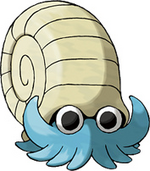| Omastar | |||
|---|---|---|---|

| |||
| Naming | |||
| Others | Omanyte (juvenile) Spiral Pokémon | ||
| Binomen | N/A | ||
| Original | オムナイト and オムスター | ||
| Romanization | Omunite and Omusutā | ||
| Morphology | |||
| Body type | Molluskan | ||
| Average height | 40 cm (Omanyte) 1 m (Omastar) | ||
| Average weight | 7.5 kg (Omanyte) 35 kg (Omastar) | ||
| Intelligence | |||
| Sentience | Sentient | ||
| Sapience | Non-sapient | ||
| Ecology | |||
| Place of origin | Kanto region, Pokémon World | ||
| Habitat | Aquatic | ||
| Diet | Carnivorous | ||
| Locomotion | Swimming | ||
| Status | EW | ||
| Behind the Scenes | |||
| Universe | Pokémon | ||
Omastar is a Rock/Water-type Pokémon species and generally regarded as extinct, although some specimens have been cloned back to life from their fossilized remains. Their juvenile stage is known as Omanyte.
Biology[]
Omanyte and Omastar are cephalopod-like mollusks with a spiral shell reminiscent of nautiloids or ammonoids. Omastar stands about a meter in height and weighs 35 kg. Its skin is usually blue, although the shiny variant is magenta. This species has a gender ratio of seven males to just one female.
While Omanyte filters down plankton on the ocean floor, Omastar is a carnivore and uses its four-part beak-jaw to crack down the shells of marine creatures such as Shellder. Its tentacles are dexterous and can be used to manipulate food and other objects.
According to Pokémon researchers, it is believed that Omastar became extinct due to its own shell becoming too heavy for it to move with agility and catch prey. As such, it ended up being left behind in the evolutionary race.
Omanyte[]

At only 40 cm in height and weighing about 7.5 kg, Omanyte is considerably smaller than its adult form. Unlike Omastar, it has round pupils, its ten tentacles are all relatively short and its mouth is not usually visible. It sustains itself on a diet of plankton.
Like a nautilus, Omanyte's shell contains several gas-filled chambers which it uses to control its fluctuation. Its tentacles, meanwhile, are used for swimming. When threatened, it can retreat into its shell for protection, although it might still be preyed upon by its natural predator, Archeops.
